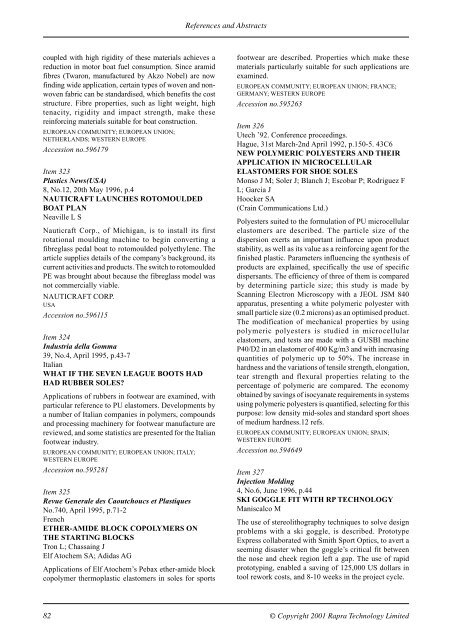Polymers in Sport and Leisure
Polymers in Sport and Leisure
Polymers in Sport and Leisure
You also want an ePaper? Increase the reach of your titles
YUMPU automatically turns print PDFs into web optimized ePapers that Google loves.
References <strong>and</strong> Abstracts<br />
coupled with high rigidity of these materials achieves a<br />
reduction <strong>in</strong> motor boat fuel consumption. S<strong>in</strong>ce aramid<br />
fibres (Twaron, manufactured by Akzo Nobel) are now<br />
f<strong>in</strong>d<strong>in</strong>g wide application, certa<strong>in</strong> types of woven <strong>and</strong> nonwoven<br />
fabric can be st<strong>and</strong>ardised, which benefits the cost<br />
structure. Fibre properties, such as light weight, high<br />
tenacity, rigidity <strong>and</strong> impact strength, make these<br />
re<strong>in</strong>forc<strong>in</strong>g materials suitable for boat construction.<br />
EUROPEAN COMMUNITY; EUROPEAN UNION;<br />
NETHERLANDS; WESTERN EUROPE<br />
Accession no.596179<br />
Item 323<br />
Plastics News(USA)<br />
8, No.12, 20th May 1996, p.4<br />
NAUTICRAFT LAUNCHES ROTOMOULDED<br />
BOAT PLAN<br />
Neaville L S<br />
Nauticraft Corp., of Michigan, is to <strong>in</strong>stall its first<br />
rotational mould<strong>in</strong>g mach<strong>in</strong>e to beg<strong>in</strong> convert<strong>in</strong>g a<br />
fibreglass pedal boat to rotomoulded polyethylene. The<br />
article supplies details of the company’s background, its<br />
current activities <strong>and</strong> products. The switch to rotomoulded<br />
PE was brought about because the fibreglass model was<br />
not commercially viable.<br />
NAUTICRAFT CORP.<br />
USA<br />
Accession no.596115<br />
Item 324<br />
Industria della Gomma<br />
39, No.4, April 1995, p.43-7<br />
Italian<br />
WHAT IF THE SEVEN LEAGUE BOOTS HAD<br />
HAD RUBBER SOLES?<br />
Applications of rubbers <strong>in</strong> footwear are exam<strong>in</strong>ed, with<br />
particular reference to PU elastomers. Developments by<br />
a number of Italian companies <strong>in</strong> polymers, compounds<br />
<strong>and</strong> process<strong>in</strong>g mach<strong>in</strong>ery for footwear manufacture are<br />
reviewed, <strong>and</strong> some statistics are presented for the Italian<br />
footwear <strong>in</strong>dustry.<br />
EUROPEAN COMMUNITY; EUROPEAN UNION; ITALY;<br />
WESTERN EUROPE<br />
Accession no.595281<br />
Item 325<br />
Revue Generale des Caoutchoucs et Plastiques<br />
No.740, April 1995, p.71-2<br />
French<br />
ETHER-AMIDE BLOCK COPOLYMERS ON<br />
THE STARTING BLOCKS<br />
Tron L; Chassa<strong>in</strong>g J<br />
Elf Atochem SA; Adidas AG<br />
Applications of Elf Atochem’s Pebax ether-amide block<br />
copolymer thermoplastic elastomers <strong>in</strong> soles for sports<br />
footwear are described. Properties which make these<br />
materials particularly suitable for such applications are<br />
exam<strong>in</strong>ed.<br />
EUROPEAN COMMUNITY; EUROPEAN UNION; FRANCE;<br />
GERMANY; WESTERN EUROPE<br />
Accession no.595263<br />
Item 326<br />
Utech ’92. Conference proceed<strong>in</strong>gs.<br />
Hague, 31st March-2nd April 1992, p.150-5. 43C6<br />
NEW POLYMERIC POLYESTERS AND THEIR<br />
APPLICATION IN MICROCELLULAR<br />
ELASTOMERS FOR SHOE SOLES<br />
Monso J M; Soler J; Blanch J; Escobar P; Rodriguez F<br />
L; Garcia J<br />
Hoocker SA<br />
(Cra<strong>in</strong> Communications Ltd.)<br />
Polyesters suited to the formulation of PU microcellular<br />
elastomers are described. The particle size of the<br />
dispersion exerts an important <strong>in</strong>fluence upon product<br />
stability, as well as its value as a re<strong>in</strong>forc<strong>in</strong>g agent for the<br />
f<strong>in</strong>ished plastic. Parameters <strong>in</strong>fluenc<strong>in</strong>g the synthesis of<br />
products are expla<strong>in</strong>ed, specifically the use of specific<br />
dispersants. The efficiency of three of them is compared<br />
by determ<strong>in</strong><strong>in</strong>g particle size; this study is made by<br />
Scann<strong>in</strong>g Electron Microscopy with a JEOL JSM 840<br />
apparatus, present<strong>in</strong>g a white polymeric polyester with<br />
small particle size (0.2 microns) as an optimised product.<br />
The modification of mechanical properties by us<strong>in</strong>g<br />
polymeric polyesters is studied <strong>in</strong> microcellular<br />
elastomers, <strong>and</strong> tests are made with a GUSBI mach<strong>in</strong>e<br />
P40/D2 <strong>in</strong> an elastomer of 400 Kg/m3 <strong>and</strong> with <strong>in</strong>creas<strong>in</strong>g<br />
quantities of polymeric up to 50%. The <strong>in</strong>crease <strong>in</strong><br />
hardness <strong>and</strong> the variations of tensile strength, elongation,<br />
tear strength <strong>and</strong> flexural properties relat<strong>in</strong>g to the<br />
percentage of polymeric are compared. The economy<br />
obta<strong>in</strong>ed by sav<strong>in</strong>gs of isocyanate requirements <strong>in</strong> systems<br />
us<strong>in</strong>g polymeric polyesters is quantified, select<strong>in</strong>g for this<br />
purpose: low density mid-soles <strong>and</strong> st<strong>and</strong>ard sport shoes<br />
of medium hardness.12 refs.<br />
EUROPEAN COMMUNITY; EUROPEAN UNION; SPAIN;<br />
WESTERN EUROPE<br />
Accession no.594649<br />
Item 327<br />
Injection Mold<strong>in</strong>g<br />
4, No.6, June 1996, p.44<br />
SKI GOGGLE FIT WITH RP TECHNOLOGY<br />
Maniscalco M<br />
The use of stereolithography techniques to solve design<br />
problems with a ski goggle, is described. Prototype<br />
Express collaborated with Smith <strong>Sport</strong> Optics, to avert a<br />
seem<strong>in</strong>g disaster when the goggle’s critical fit between<br />
the nose <strong>and</strong> cheek region left a gap. The use of rapid<br />
prototyp<strong>in</strong>g, enabled a sav<strong>in</strong>g of 125,000 US dollars <strong>in</strong><br />
tool rework costs, <strong>and</strong> 8-10 weeks <strong>in</strong> the project cycle.<br />
82 © Copyright 2001 Rapra Technology Limited










